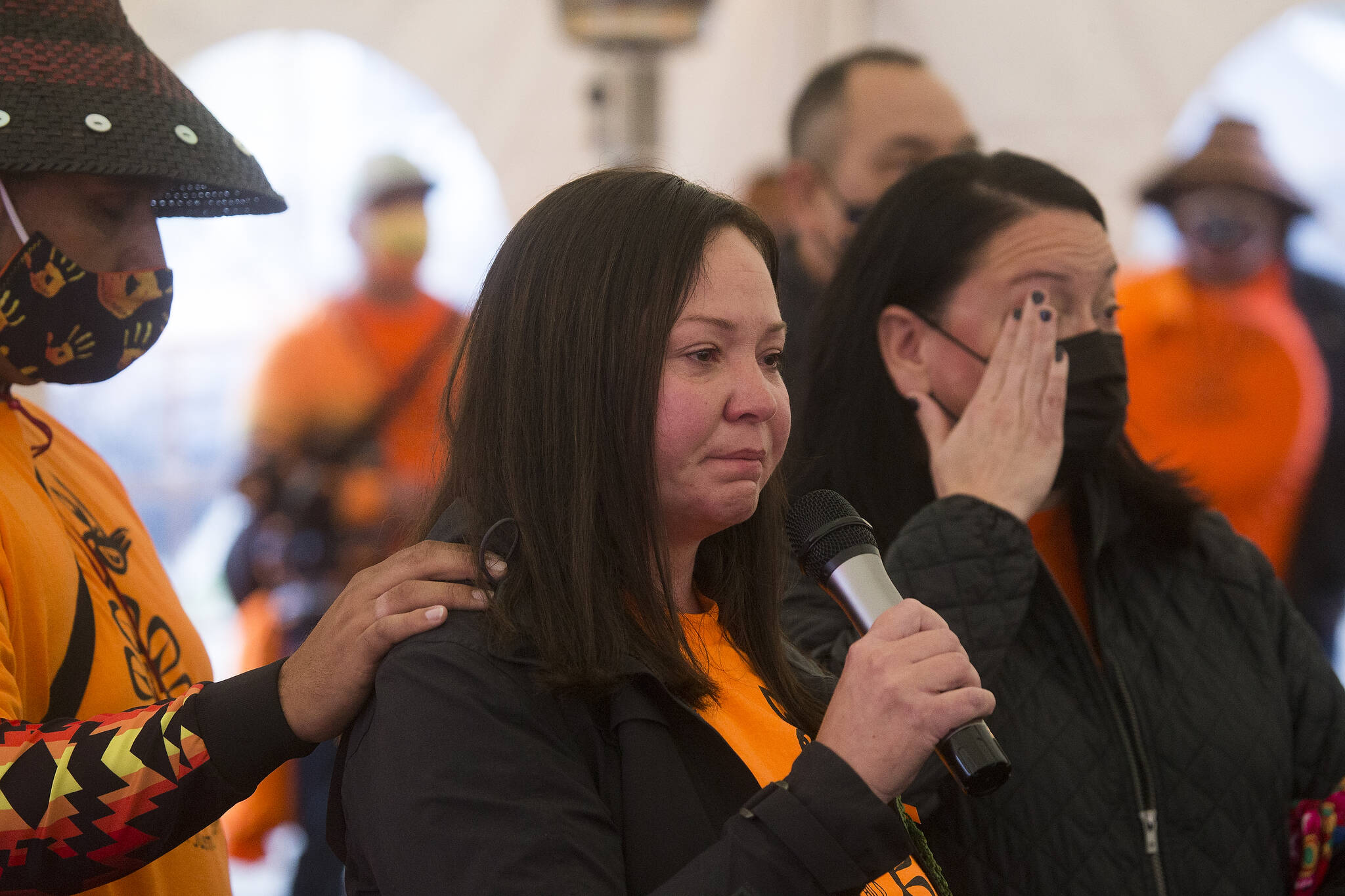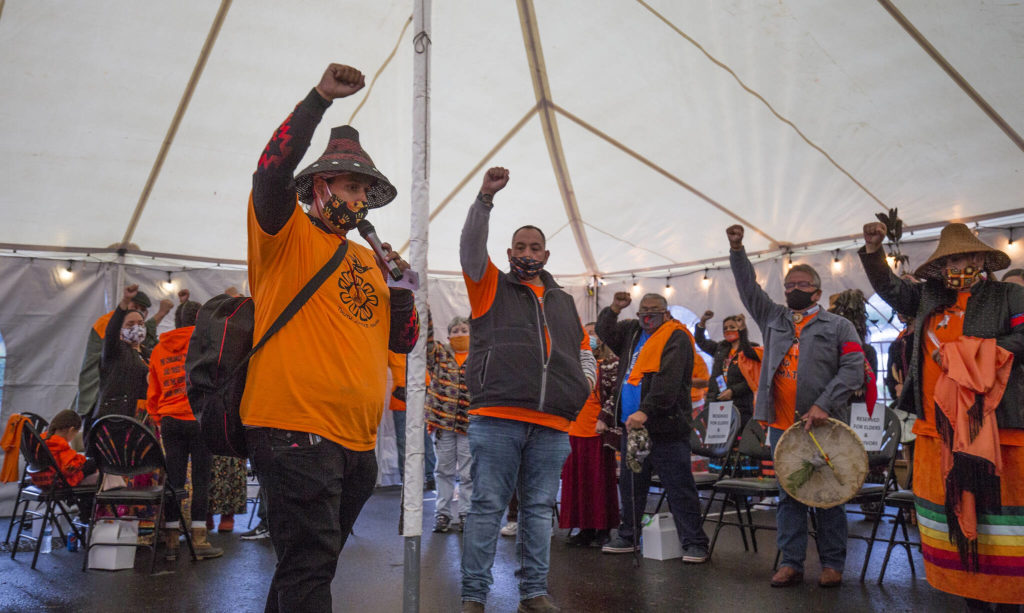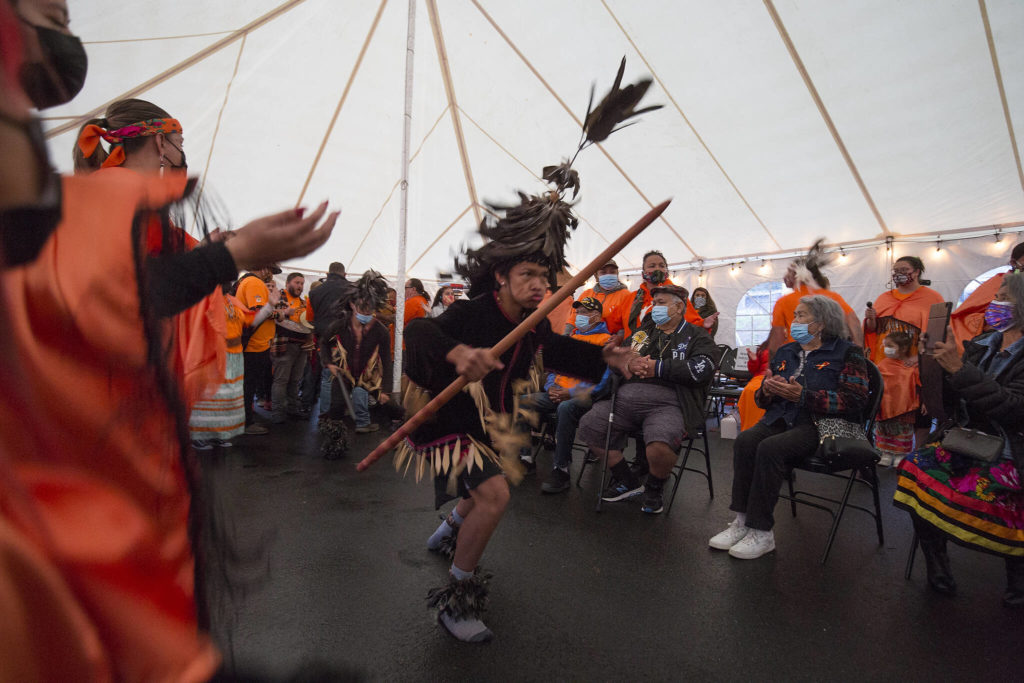This article contains details that may be distressing to some.
TULALIP — Standing in front of the last remnant of the boarding school on Tulalip Bay Thursday evening, Tulalip leaders tearfully shared their families’ stories.
Rochelle Lubbers, chief administrative officer for the tribes, is the great-granddaughter of Elsie Price, who attended the boarding school.
“She entered that boarding school at the same age as my youngest child,” Lubbers said. “And when I looked at him today, and I realize how much love and support he needs to thrive.”
From 1857 to 1932, hundreds of Native youth from across the state and as far as Alaska were taken to the Tulalip Boarding School. There, they were beaten for speaking their Native languages. They began industrial jobs as elementary age students. They didn’t get to see their parents for ten months of the year, and many of them never came home.
The school closed in 1932, and for many families, the wounds are fresh.
“The historical trauma that is caused from generation to generation on the families, the parents who lost parenting skills, who went into depression,” Tulalip Chairwoman Teri Gobin said. “My heart breaks for each and every one of those kids, the survivors. But, a lot of kids never made it home.”
Thursday was Residential Boarding School Awareness Day, also known as Orange Shirt Day.
The dining hall where scores from the Tulalip community gathered Thursday evening, is a tangible reminder of the horrors Native children endured during the boarding school era.
“If you go downstairs in the basement, in the very back, the kids that got sent there for being bad — that got locked up down there — carved their names into the wood,” said tribal Councilmember Misty Napeahi. “I can’t imagine somebody coming to my house, taking my baby. It just kills me to think that they actually lived through that.”
Between stories, Tulalip youth, alongside their adult peers, performed a welcome song and Snohomish war song.
This is something their ancestors couldn’t have done at that age.
“I think this is the first time I can — in my lifetime — remember coming together like this,” Napeahi said. “We have to recognize that we survived this. We’re strong, resilient Indian people. And we’re that way, because we’re a community.”
This year, the tribes passed a resolution proclaiming Sept. 30 as Orange Shirt Day, a day of remembrance and awareness for residential boarding schools. This will allow the community to gather and share these stories for years to come.
Earlier this month, the Marysville School District also proclaimed Sept. 30 as Orange Shirt Day. Several school leaders came out to the dining hall, wearing orange in solidarity.
After Tulalip youth delivered boxed dinners to a full front row of elders and boarding school survivors, students opened the event with a prayer in Lushootseed.
Later, Tulalip DJ Monie Ordonia led a breathing exercise, urging the community to release their ancestors’ hurt.
“My mother was in boarding school and I always wondered why she was suicidal,” Ordonia said. “In doing the work. I understand the hurt that she had all these years. So as we wait for the drummers and the singers to come out, I want you all to take a moment. Take a deep breath in. Because this is deep work.”
Less than 100 years ago, school employees whipped Tulalip youth for speaking Lushootseed.
While their white peers attended day schools and returned home to their families after the last school bell rang, Tulalip youth spent the entire school year under the supervision of burly school staff.
If school officials found students that attempted to run away from the campus, the students were “hogtied” at their ankles and wrists and left in the halls.
Inside the school, students woke to a bell at 5:30 a.m., performed military-like drills, reported to industrial jobs — milking cows, working in the hospital or doing laundry for the hundreds of students living at the school — and spent their evenings studying.
They had no toys. They could not see their families.
Many became ill from tuberculosis, pneumonia and influenza and some died. There was only one doctor on the reservation.
“They really, really honest to God neglected us,” said Tulalip tribal member Arnold McKay in a 1993 lecture series sponsored by the Marysville School District.
McKay, of Lummi descent, was among the thousands of Native students from across the Pacific Northwest who attended the boarding school at Tulalip.
Native parents gained the right to deny their children’s placement in off-reservation schools in 1978, when the Indian Child Welfare Act was signed into law. But, the damage was already done.
“We have to heal from this,” Gobin said. “People need to hear the stories to know what happened to our people.”
Isabella Breda: 425-339-3192; isabella.breda@heraldnet.com. Twitter: @BredaIsabella.
Talk to us
> Give us your news tips.
> Send us a letter to the editor.
> More Herald contact information.




























